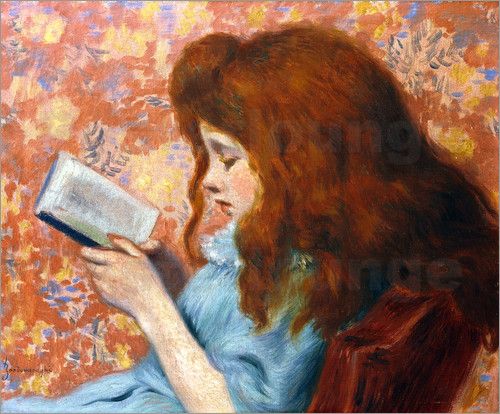
When I was in Germany, just before Christmas, I bought myself a desk calendar which gave you a new painting every day. I was fascinated by today’s picture of a young girl reading entitled Lesendes Mädchen (Girl Reading) by Federico Zandomeneghi. I had never heard of the artist and thought it would be interesting to look at his life and his some of his beautiful works of art. He would become known for his many pastel portraits of ladies and children.
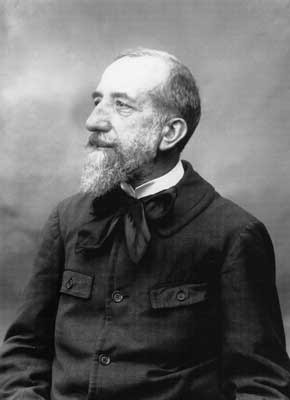
Federico Zandomeneghi was born in Venice in June 1841. He came from a family line of sculptors. Pietro, his father, was a neoclassical sculptor as was his grandfather Luigi but unlike his father and grandfather Federico, and much to their annoyance, he favoured painting to sculpture. In 1856, at the age of fifteen, he enrolled on a painting course at the Academia di Belle Arti in Venice and then later studied at the Accademia di Belle Arti di Brera in Milan, where he studied under the neoclassical-style painter Giralamo Michelangelo Grigoletti and Pompeo Marino Molmenti. Venice was under Austrian rule when Napoleon was defeated in 1814 and it became part of the Austrian held Kingdom of Lombardy-Venetia. Venice was firmly under the control of Austria and as such the Venetian citizens were conscripted into the army. To escape conscription, Federico fled his city in 1859 and went to Pavia, where he enrolled at the university. In 1860, when he was nineteen years of age, he joined the military forces of Guiseppe Garibaldi as one of the volunteers in The Expedition of the Thousand, part of the Risorgimento, the push for Italian unification. As a Venetian this was looked upon as a kind of treachery. His flight from Venice in 162 to Florence to avoid conscription resulted him being charged, in absentia, with desertion.
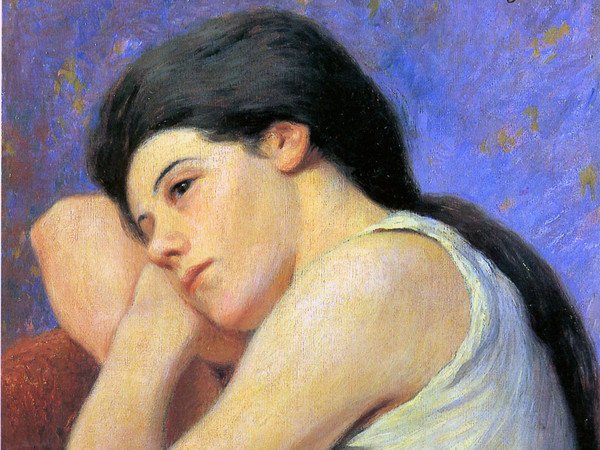
As a young aspiring artist Federico wanted to mix with other artists in the Tuscan city and by doing so assimilate their views of art. One of the favoured meeting places for the artists was the Caffè Michelangelo . It was here that the Macchiaioli met. The Macchiaioli, which literally means patch- or spot-makers, was a group of rebellious Italian artists based in Tuscany during the second half of the 19th century and was formed more than ten years before the French Impressionists came onto the scene. They rebelled against academic artistic training and many art historians believe they brought about a breath of fresh air into Italian painting. They ignored the type of painting which was popular at the time such as Neoclassicism and Romanticism. They were looked upon as the founders of modern Italian painting. The Macchiaioli believed that areas of light and shadow, or macchie were the most important parts of a painting and when Italian artists spoke of macchia they were talking about the sparkling quality of a drawing or painting.
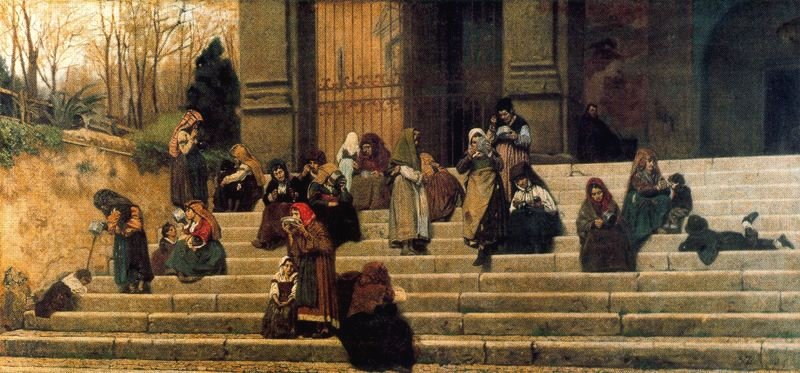
The Poor on the Steps of Ara Coeli in Rome by Zandomeneghi is now housed at the Pinaconteca Brera in Milan. It is a fine example of verismo the nineteenth century Italian painting style and was a style frequently used by the Macchiaioli. It is a style of painting we would term as realism. It features a group of poor people, men, women and children sitting on the steps of Santa Maria in Aracoeli (St. Mary of the Altar of Heaven), one the oldest basilicas in Rome.
——————————————————————–
There was a strong connection with French art as many of the Macchiaioli were influenced by the French artists such as Courbet and Corot who belonged to the Barbizon School as well as other nineteenth century plein air painters whose works the Macchiaioli artists were able to see when they visited the French capital. En plein air painting was at that time a ground breaking method of painting but its proponents believed that it allowed for a new vibrancy and naturalness in the reproduction of light which would have been lost if the painting had been carried out in a studio. Some of the members of the Macchiaioli, like Federico, had fought alongside Garibaldi in his effort to attain Italian unification. Many of the works of the Macchiaioli featured grand battles scenes of the Risorgimento as well as landscapes and genre paintings featuring both the bourgeoisie and peasants.
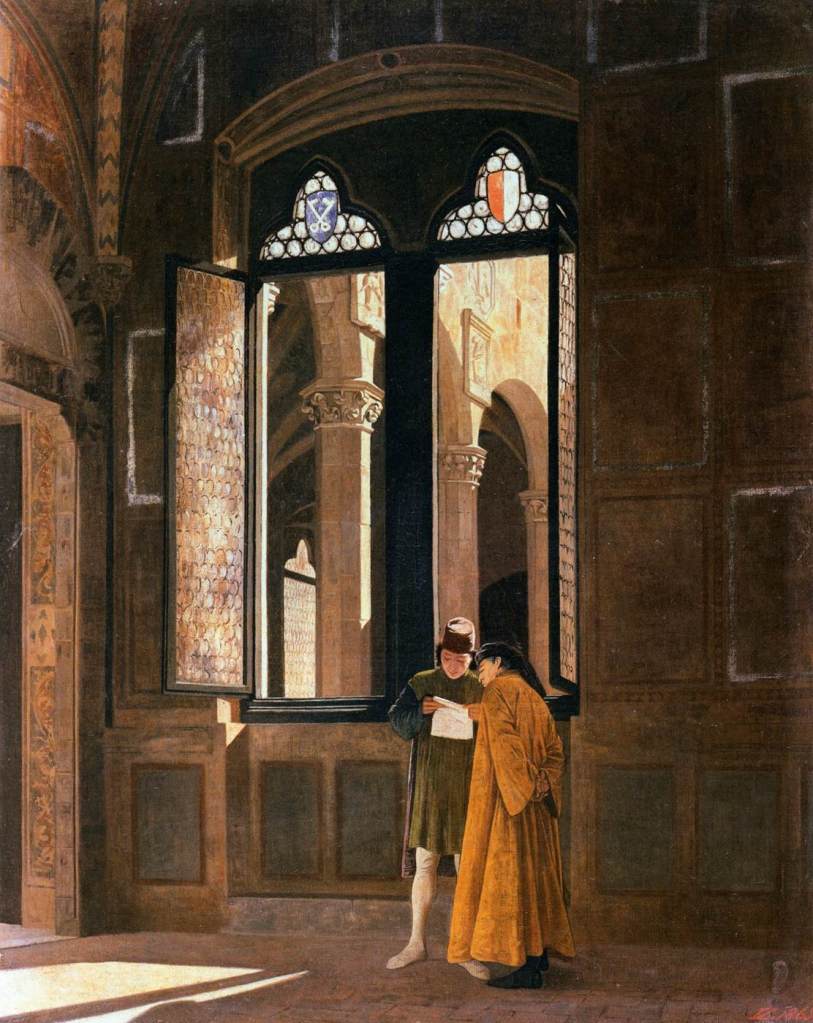
Another painting completed by Zandomeneghi whilst he was living in Florence is one of my favourites. It is entitled Palazzo Pretorio and was completed in 1865. It can now be found in the Museo d’Arte Moderna, Ca’ Pesaro, Venice. The work of art was exhibited that year in the rooms of the Società Veneta Promotrice (Venetian Promoter of Fine Arts) which was based in Palazzo Mocenigo at San Benedetto. The depiction of light and shade we see in the painting was strongly influenced by the Macchiaioli artists of Florence.
————————————————————–
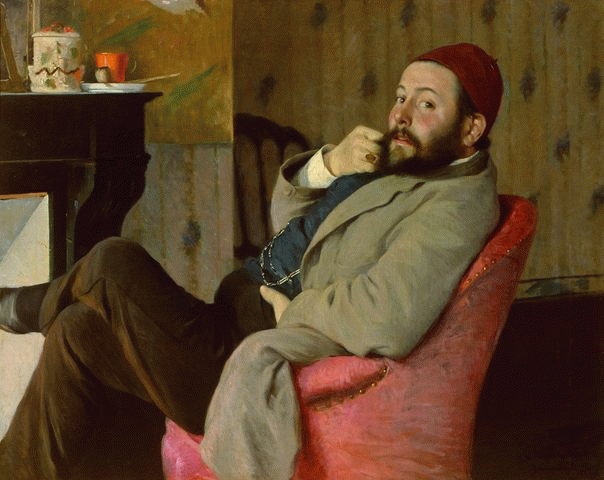
Whilst in Florence and through his association with the Macchiaioli artists, Federico Zandomeneghi met the Italian art critic Diego Martelli. Martelli was a great supporter of the painters of the Macchiaioli and would often invite them up to his large Tuscan estate in Castiglioncello which was an ideal setting for their en plein air painting sessions. Martelli wrote fervently about realism in art and favoured the works of Gustave Courbet as well as the plein air artists of the Barbizon School. He made a number of trips to Paris and its thought that he persuaded Zandomeneghi to leave Florence and go to live in the French capital. Through their correspondence Zandomeneghi introduced Martelli to the works of the Impressionists so much so that it is said that Martelli was one of the first and leading supporters of Impressionism in Italy.
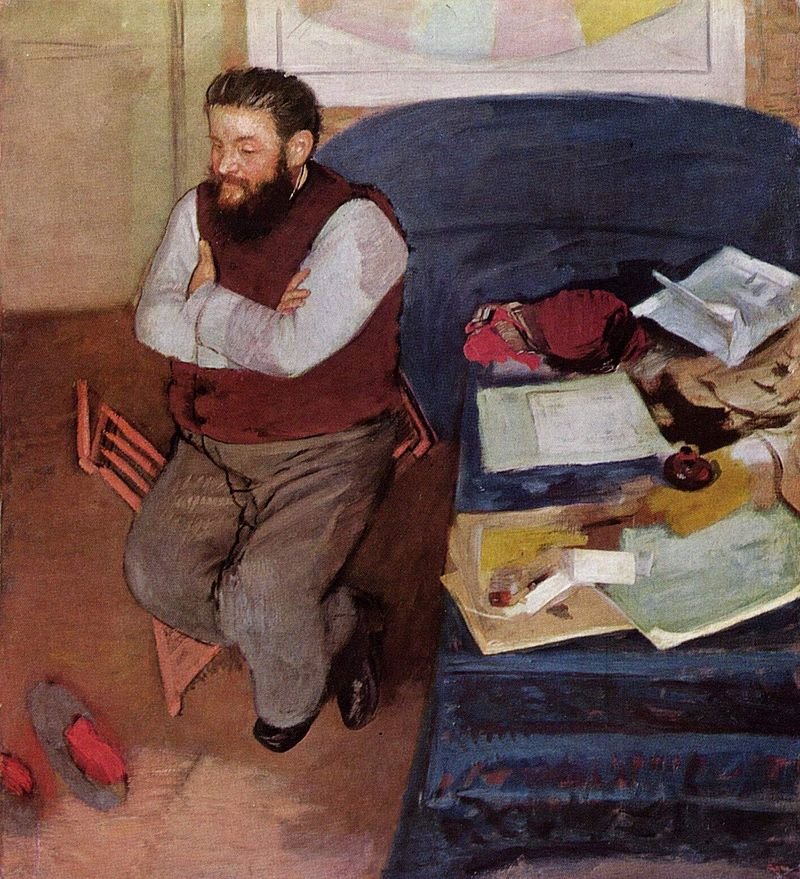
Like Zandomeneghi, Martelli became good friends with Degas who painted his portrait in 1879. The Degas portrait is unusual in as much as the sitter is viewed from above which is somewhat unflattering as it accentuates the corpulence of Martelli. We see Martelli sitting unsteadily on a small stool. To his left is a table, scattered on which are numerous objects belonging to the sitter. The addition of these items was a trademark of Degas’ portraits as he felt it told viewers more about the subject of the portrait. The painting is now housed in the Scottish National Gallery.
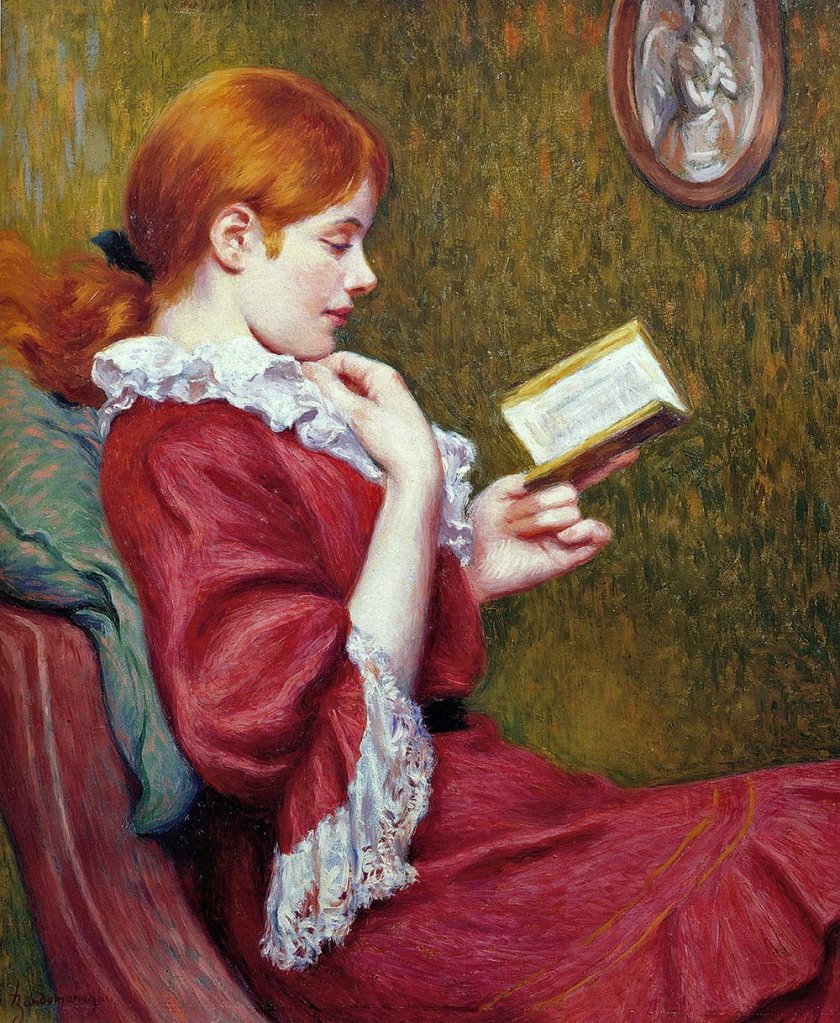
In 1874, Federico, now thirty-three years of age, moved to the art capital of Europe, Paris, and little did he know then, he would never return to his Italian homeland. On his arrival in Paris, as was the case when he arrived in Florence, he wanted to immerse himself into the life of an artist and mix with the artists of Montmartre. To be an artist in the French capital at this time was a chance to witness the birth of what would later be termed by the art critic, Louis Leroy, as Impressionism.
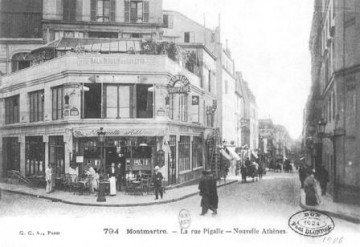
The year 1874 was the year of the Impressionist’s first annual exhibition in Paris. Federico would often frequent the Café de la Nouvelle-Athènes on Place Pigalle. It was here that he first met and befriended Edgar Degas, who was seven years his senior. It is said that we are often drawn to people who have the same characteristics and the same looks upon life and as such Degas and Federico Zandomeneghi were well matched. Both were recalcitrant and often boorish and this similarity of behaviour ensured they would remain life-long friends! Although great friends with Degas, Federico was more influenced by the works of Renoir and Mary Cassatt and the way they portrayed women in their art work. This was to lead to many of his works featuring females going about with their daily chores or being immersed in reading. Zandomeneghi liked to portray through his artwork, and like that of the Impressionists, the elegant high society of the French capital but his paintings were not imitations of the Impressionists’ works. He had his own inimitable style.
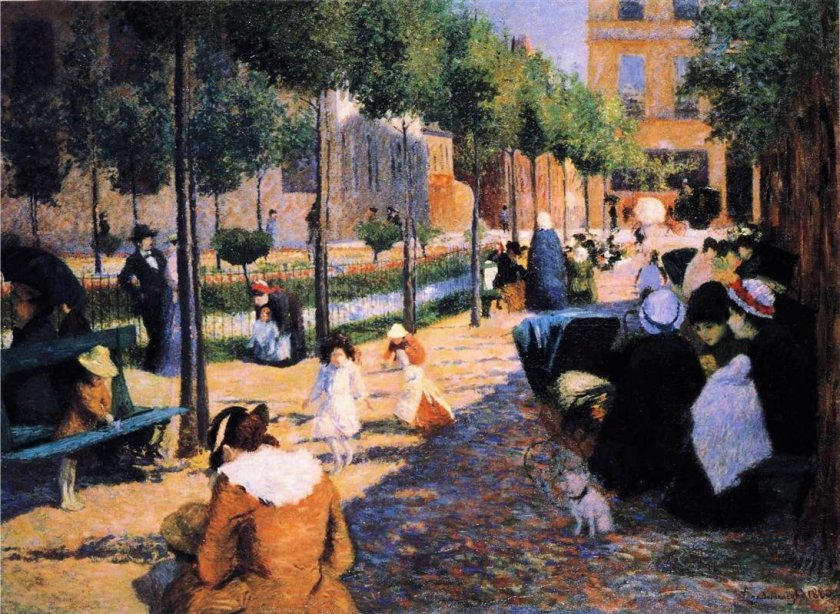
The Impressionists had by 1879 held three annual exhibitions and Degas persuaded Federico to exhibit some of his work at the fourth annual exhibition at the Avenue de l’Opéra, during the months of April and May in 1879. Besides Federico there were three other “first appearances” exhibiting at the Fourth Impressionist Exhibition, the husband and wife Impressionists Félix and Marie Braquemond and Paul Gaugin. Federico went on to exhibit at the fifth (1880), sixth (1881) and the eighth and final exhibition in 1886. To sell one’s work one has to have a good dealer and through the good auspices of his Impressionist friends Federico was taken on by the gallery owner and art dealer, Paul Durand-Ruel who acted as his sole agent. It was this Parisian art dealer who changed the fortunes of Federico when he exhibited the Italian artist’s work in America. In the 1890’s, having had to supplement his income from the sale of his paintings by providing illustrations for Paris fashion magazine, once his work was seen in America he was inundated with commissions. It was around this time that Federico changed the medium in which he worked, now favouring in pastels.
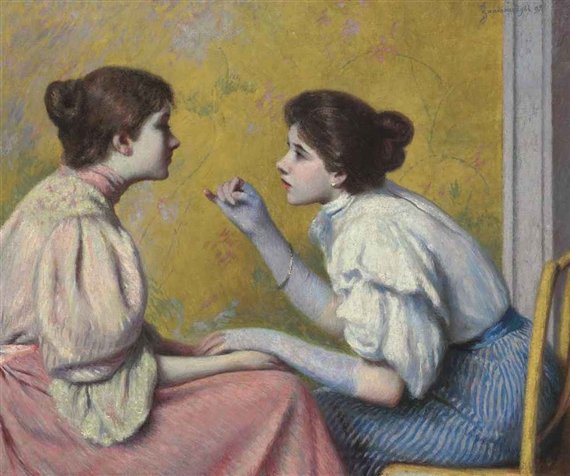
Zandomeneghi will always be remembered for his female portraiture. He seemed to concentrate his depictions of women who were mothers going about their everyday life. He often liked to show in his paintings the ease in which women interacted with each other. There was a warmth about his pictorial depiction of females and this may be because of the way he was influenced by the works of Berthe Morisot and Mary Cassatt. Enrico Piceni, the Italian writer and art critic who wrote a biography about Zandomeneghi and who, in 1984, wrote a book entitled Three Italian friends of the impressionists : Boldini, De Nittis, Zandomeneghi, wrote of Zandomeneghi’s work:
“…Zandomeneghi knows how to differentiate himself from his closest colleagues, Degas and Renoir, by surpassing the glossy and even fierce chronicle style of the first thanks to adding a warm and affectionate emotional involvement in the subject, and by transferring the deification of the ideal woman typical of the second in a more bourgeois reality interwoven with truth but able to transform a simple story in a tremor of poetry…”
A good example of the way Zandomeneghi depicted a close relationship between two women is in his 1895 work entitled Conversazione interessante (Interesting Conversation). Before us, we see two women locked in conversation. There is a gentleness about the scene. There is no wild animation. We feel drawn into the scene as a friend who is being admitted into their private world. Both women are wearing light fashionable wide-sleeved shirts which were all the fashion in the 1890’s. This painting highlights the beautiful technique Federico was to often use. There is a lightness of touch and the artist demonstrates an amazing insight in the way he portrays the mood of the sitters. The two women in the painting are totally absorbed in their conversation. Their hands touch. They only have eyes for each other in this intimate and yet non-sexual depiction. The art critic and writer Francesca Dini in her 1989 book, Zandomeneghi, la vita e le opera, wrote of this work:
“…Conversazione interessante (Interesting Conversation), is among the most famous works produced by the Venetian painter at the beginning of his relationship with Durand-Ruel. The brilliance and chromatic refinement of the composition are emphasized by the balance of the scene and the richness of the materials chosen for the dresses of two young women, who are wearing light shirts with wide sleeves ‘double sboffo’, very fashionable in the last decade of the century. The provenance of the painting is notable as it belonged, among others, to the greatest admirers and collectors of paintings by the artist…”
Federico Zandomeneghi died in Paris on the last day of 1917, aged seventy-six. It was not until 1914, three years before his death, that he was given his first one-man show which was at the Venice Biennale of that year in his native country.
There were so many paintings by Zandometeghi I could have showcased but I have just chosen some of my favourites but I hope you will search out more of his works.
